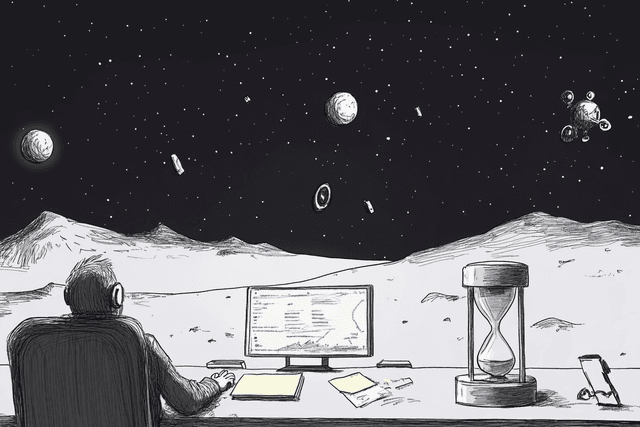A developer is in the middle of writing code for a new feature. Before finishing, they check Slack to respond to a teammate's question. Right after, a calendar notification reminds them about an upcoming sprint planning meeting. They attend the meeting, return to their editor, and try to remember what they were doing. A 2024 study of 5,000 developer tasks revealed that self-interruptions (like voluntarily checking Slack) are more disruptive than external ones, contrary to common perception.
This sequence is common in software development. Each interruption pulls the developer into a new mental space, leaving behind fragments of the previous task. When this happens several times a day, the ability to focus and complete work consistently starts to degrade.
This article explains context switching in software engineering, how it affects productivity, and what practices and tools help reduce it.
What Is Context Switching in Software Engineering?
Context switching in software engineering means moving rapidly between different tasks, projects, or mental states. This includes jumping from writing code to reviewing a pull request, responding to chat messages, or attending a meeting. Each switch requires the developer to pause one task, mentally load the next, and eventually return to the original task—often starting over to regain context.
This differs from multitasking. In multitasking, someone tries to handle multiple tasks at once. Context switching involves stopping one task to work on another, not doing them simultaneously. It's also different from task prioritization, where tasks are arranged by importance and handled in sequence with minimal disruption.
Context switching introduces friction. Each change in focus creates an invisible cost: time spent reorienting, details forgotten, and effort duplicated.
Key aspects of context switching:
Mental reset: Each switch requires loading a different set of information into working memory
Task interruption: Work on one task stops completely to handle another
Return cost: Coming back to the original task requires time to remember where you left off
The Cognitive Load of Context Switching
When developers switch tasks, their brains must unload current information and load new details. This mental shift isn't instant—it takes time and energy.
Even after changing tasks, part of the mind may still focus on the previous one. Psychologists call this "attention residue"—when thoughts from a previous task linger and interfere with the current one. This residue makes it harder to concentrate fully on the new task and increases the time needed to return to the previous task later.
The human brain isn't designed for rapid context switching. Unlike computers that can instantly load and unload memory, our minds need transition time. Research in cognitive psychology shows that each context switch creates a small cognitive deficit that accumulates throughout the day.
The Impact of Context Switching on Developer Productivity
Context switching significantly reduces a developer's ability to maintain focus. When attention is divided across multiple tasks, it becomes harder to concentrate on any single one. This leads to more mistakes, forgotten details, and incomplete work.
Interruptions also increase the time needed to complete tasks. Each switch creates a delay before developers can resume their original work with full context. According to a University of California study, it takes an average of 23 minutes and 15 seconds to fully return to a task after an interruption. These delays add up throughout the day, reducing total output.
A study from the University of California found that it takes an average of 23 minutes and 15 seconds to fully return to a task after an interruption. For developers, this means that just 5-6 interruptions can consume nearly half a workday in recovery time alone.
Frequent task switching also contributes to mental fatigue. Developers managing multiple threads of work at once experience higher stress levels. Over time, this can lead to burnout, especially when the workload spans different projects or domains.
Quantifying the Cost of Context Switching
Research has shown that context switching can reduce productivity by 20% to 80%, depending on the type and frequency of task changes. This range reflects the time lost during each switch and the additional effort required to resume the original task.
The cumulative effect of switching costs impacts engineering velocity. Each switch introduces a small delay, but when switches happen repeatedly across a team, overall progress slows. These delays aren't always visible in metrics like ticket completion but often appear in reduced throughput and slower code delivery.
For example, a developer who experiences 10 context switches in a day might lose 1-2 hours of productive time just transitioning between tasks. Across a team of 10 developers, this could mean 10-20 hours of lost productivity every day.
How Context Switching Hinders Code Quality
Examples of quality issues from excessive context switching: Context switching across a 10-person development team translates to 10-20 hours of lost productivity daily—equivalent to hiring two additional developers to offset the deficit.
Technical debt often grows in environments where deep work is interrupted. Complex systems require sustained focus to understand and modify correctly. Without long periods of uninterrupted time, developers are more likely to apply short-term fixes instead of addressing root causes.
Examples of quality issues from excessive context switching:
Incomplete error handling
Duplicated code instead of refactoring
Security vulnerabilities from rushed implementations
Inconsistent patterns across the codebase
Effective Strategies to Reduce Context Switching
Focus blocks are scheduled periods of uninterrupted work time. During these blocks, notifications are silenced and meetings are avoided. This creates space for deep concentration on one task without switching to others.
Task batching involves grouping similar tasks together and completing them in sequence. For example, reviewing multiple pull requests at once instead of throughout the day reduces the number of mental resets required. Day theming is a related approach where specific types of tasks are assigned to specific days, such as dedicating Tuesdays to planning and Wednesdays to implementation.
Asynchronous collaboration reduces the need for real-time responses. Instead of immediate replies in chat or meetings, team members document updates and decisions in tools like version control comments or shared documents. This allows each person to respond when they are not engaged in focused work.
Practical strategies developers can implement today:
Time blocking: Schedule 2-3 hour blocks in your calendar for focused coding
Notification batching: Check emails and messages at specific times (e.g., 10am, 1pm, 4pm)
Task completion: Finish one task before starting another whenever possible
Meeting batching: Group meetings together on specific days or times of day
Automating Workflows to Minimize Task Switching
CI/CD pipelines help reduce manual steps in the development and deployment process. Once code is merged, automated systems can run tests, build artifacts, and deploy to environments without manual intervention.
Code quality tools can scan code automatically for formatting issues, security risks, and other rule violations. This reduces the need for developers to shift attention away from their current task to perform manual checks or reviews.
A good example is using pre-commit hooks that automatically format code and run linters before committing. This eliminates the need to switch context from writing code to fixing style issues, then back to coding.
Leveraging AI Assistants to Preserve Flow State
AI-powered coding assistants provide quick code examples, documentation references, or suggestions without requiring developers to open a browser or switch to another tool. This reduces interruptions caused by external lookups.
Repetitive tasks, such as writing boilerplate code or refactoring variable names, can be delegated to AI tools. This allows developers to maintain focus on the primary logic or design of the system being built.
For instance, an AI assistant can generate unit test templates based on function signatures, saving the developer from switching between writing production code and test code repeatedly.
Tools and Techniques to Manage Context Switching
Time blocking divides a calendar into fixed segments for specific tasks. Developers use this method to reserve uninterrupted time for focused work. Distraction-free tools, such as full-screen editors or "do not disturb" settings, help reduce external interruptions during those blocks.
Kanban boards help visualize work in progress. They show tasks in columns such as "To Do," "In Progress," and "Done." Setting work-in-progress (WIP) limits restricts how many tasks can be in each column at once. This helps reduce how often someone switches between tasks before completing one.
Tool Type
Examples
How It Reduces Context Switching
Focus Apps
Forest, Focus@Will
Block distracting websites and apps
Task Management
Trello, Asana
Visualize and limit work in progress
Communication
Slack (with DND)
Batch notifications and set availability
Development
Trunk Check
Automate code quality checks
Trunk Check is a tool that runs automated checks on code for formatting, security, and quality issues. It runs in the background and provides feedback without requiring manual review. This helps reduce interruptions caused by context switching to review or fix code style issues manually.
Measuring and Optimizing Context Switching with Metrics
Lead time measures the time from when work is requested to when it is completed. Cycle time measures the time from when work begins to when it is finished. Tracking these values over time can help detect patterns in workflow efficiency.
Context switching rates can be estimated by counting the number of tasks a developer interacts with each day or by logging changes between tools and environments. Teams can also identify top sources of interruptions—such as frequent meetings, Slack messages, or code review requests—and document them for analysis.
Team agreements can help establish expectations around communication and task handoffs. For example, a team may agree to use asynchronous messages for non-urgent questions or set fixed hours for focused work. These agreements help reduce unplanned context switches caused by unclear expectations.
Common metrics to track:
Number of different tasks worked on per day
Time spent per task before switching
Interruption frequency during focus blocks
Ratio of meeting time to focused work time
Creating a Context-Switching-Aware Engineering Culture
Building a culture that respects focused work time starts with leadership. When managers and senior developers model good focus habits, other team members feel permission to do the same.
Team norms around communication can significantly reduce interruptions. For example, adopting a system where different communication channels have different response time expectations:
Email: Response within 24 hours
Chat: Response within 4 hours (non-urgent)
Direct message: Response within 1 hour (somewhat urgent)
Phone call: Immediate response (truly urgent)
Documentation also plays a key role in reducing context switching. Well-documented code, architecture decisions, and processes allow developers to find information without interrupting colleagues. This creates a more self-service environment where context switching due to information seeking is minimized.
Physical workspace considerations matter too. Whether in an office or working remotely, creating an environment that minimizes external distractions helps maintain focus. Noise-canceling headphones, dedicated work spaces, and visual signals (like a "focus mode" indicator) can all help reduce unnecessary interruptions.






